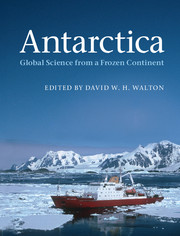Book contents
- Frontmatter
- Contents
- List of contributors
- Introduction
- 1 Discovering the unknown continent
- 2 A keystone in a changing world
- 3 Ice with everything
- 4 Climate of extremes
- 5 Stormy and icy seas
- 6 Life in a cold environment
- 7 Space science research from Antarctica
- 8 Living and working in the cold
- 9 Scientists together in the cold
- 10 Managing the frozen commons
- 11 Antarctica: a global change perspective
- Appendix A Visiting Antarctica
- Appendix B Further reading
- Acknowledgements
- Index
8 - Living and working in the cold
Published online by Cambridge University Press: 05 March 2013
- Frontmatter
- Contents
- List of contributors
- Introduction
- 1 Discovering the unknown continent
- 2 A keystone in a changing world
- 3 Ice with everything
- 4 Climate of extremes
- 5 Stormy and icy seas
- 6 Life in a cold environment
- 7 Space science research from Antarctica
- 8 Living and working in the cold
- 9 Scientists together in the cold
- 10 Managing the frozen commons
- 11 Antarctica: a global change perspective
- Appendix A Visiting Antarctica
- Appendix B Further reading
- Acknowledgements
- Index
Summary
Adventure is just bad planning.
Roald AmundsenNot many people get to work in Antarctica and, for many of those that do, it can prove a life-changing experience. Every year over 2000 scientists and support personnel travel south to conduct scientific research. They come from over 30 countries and, while some stay only a few days, others stay for months or even a year or two. Some spend their time at the 40 permanent research stations scattered around the continent that are open year around; others make use of the 30 stations that are used in the summer only or undertake long research cruises offshore, and many more set up field camps deep in the most remote parts of the continent.
The modern research stations have little in common with the historic huts of Robert Falcon Scott and Ernest Shackleton. Built in the early 1900s, their wooden buildings provided little more than shelter from the cold and wind and a place to wait out the winter. But today's stations, from the smallest, like Norway's Tor (home to only four), to its largest, the United States’ McMurdo (where over 1000 live in the summer), Antarctic research stations are like self-sufficient villages. Each needs facilities for power generation and for dealing with waste, for making fresh water and for medical care. The stations must be able to store and prepare food and provide accommodation for scientific and support personnel as well as be capable of maintaining and servicing vehicles and running telecommunications units, and often maintain sophisticated laboratories.
- Type
- Chapter
- Information
- AntarcticaGlobal Science from a Frozen Continent, pp. 229 - 252Publisher: Cambridge University PressPrint publication year: 2013



